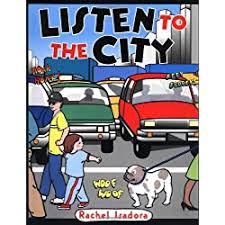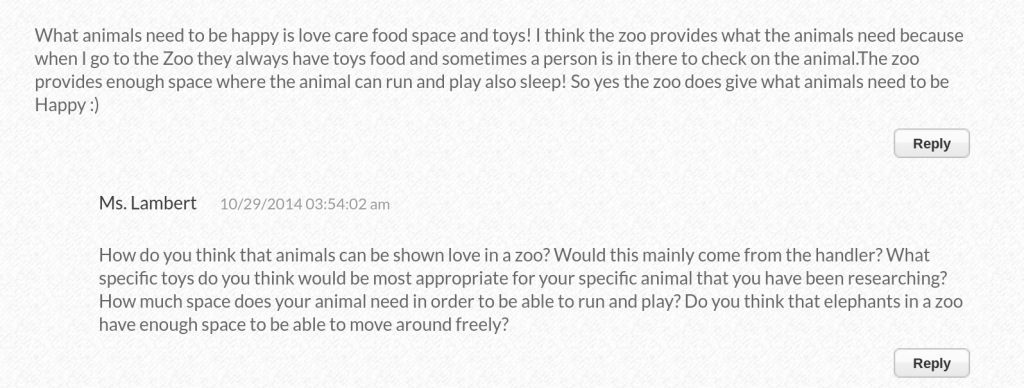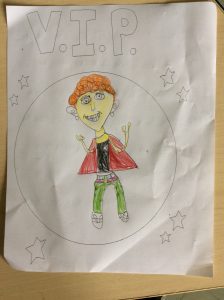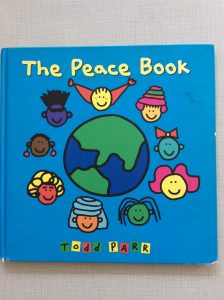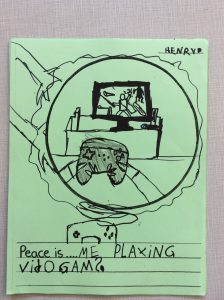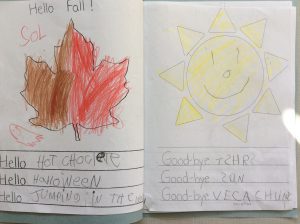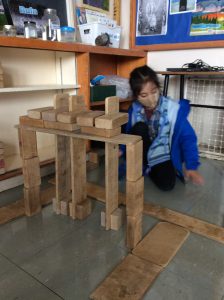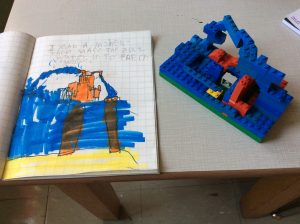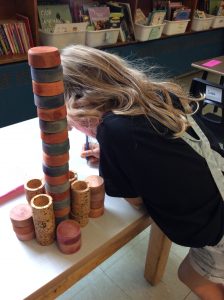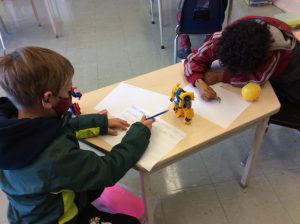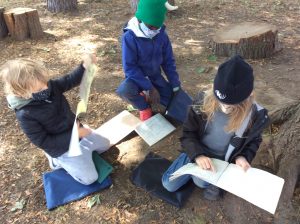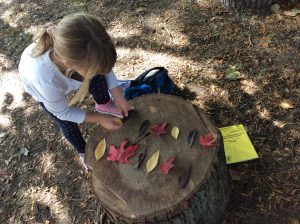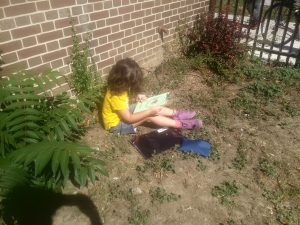….FLOCK Together!!
In preparation for the Spring Equinox, which is usually held in the Rainbow Garden, I started to think creatively about how we could gather as a whole school community and respect COVID health and safety protocols. I wanted to incorporate dance, and then I remembered about flocking.
WTF?
Flocking is a type of movement improvisation, where the whole group mirrors each other’s movement. Students can be organized in a straight line or in the shape of a diamond. In flocking, there is one student who leads a movement, which is followed by the other students.
Different students can become the leader, just like birds do when they are flying together, by changing their position. In a diamond formation, the student at the top of the diamond is the leader. When everyone rotates a quarter turn, there is a new leader at the top of the diamond. Flocking can be inspired by music that is played, but I wanted to integrate text and embody the Land Acknowledgment.
Thanksgiving Address:
We are learning that many Indigenous and First Nations communities offer greetings and gratitude at the beginning of every gathering. The Haudenosaunee Confederacy, which includes the nations of Cayuga, Onondaga, Tuscarora, Seneca, Mohawk and Oneida, share The Thanksgiving Address. Here is a video that describes the importance of this text.
In the Thanksgiving Address, all parts of creation are recognized with honour and respect. Here is a link to the text we used. We have been deepening our understanding of this important protocol by speaking and listening to the words, drawing, writing and reflecting. This was our first time exploring the text through choral movement and mindfulness. It was very powerful.
Bear Song:
As educators, it is important to build relationships with First Nations and Indigenous families, which includes consultation and collaboration, and invitations to share knowledge with the community. At our school, we are fortunate to have several parents who have shared songs, drumming and dancing at different events. After gathering in the field, Archer and Ansley sang the Anishinaabe Bear Song to welcome Spring. Here is the song performed by Turning Point Women’s drum group from Skownan, Manitoba.
Medicine Wheel Teachings:
In the article, “Teaching by the Medicine Wheel: An Anishinaabe framework for Indigenous education,” Dr. Nicole Bell (2014) describes how schools might integrate Indigenous knowledge, and create a process of education that is respectful and culturally relevant for Indigenous families. Bell explains that while there are some variations of teachings and representations of the Medicine Wheel, there are common threads of understanding, including the importance of appreciating and respecting the interconnectedness and interrelationships of all things.
I wanted to incorporate Medicine Wheel teachings into our Spring Equinox gathering. The Medicine Wheel is a circle that is divided into four parts, which represent the four directions (East, South, West, North) using four different colours. Each of the directions include teachings that are interdependent, including the four seasons, stages of life, times of day, medicines, life givers, and learning process.
We organized the students into four sections, from youngest to oldest, starting in the East. Everyone was standing in the field, facing the same direction. As the Junior students read the Thanksgiving Address, everyone followed the movements of the Junior leader at the top of the diamond. The refrain, “And Now Our Minds Are One”, was repeated in chorus, and was the signal for everyone to rotate a quarter turn to the right together. Then, we started to follow the movements of a new leader. The rotations and the movements continued until the Thanksgiving Address was finished.
It was flocking amazing to welcome the new season with movement, gratitude and respect. Happy Spring!! 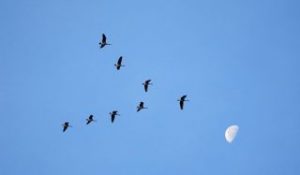
M is for Mindfulness
My inbox and social media feeds are filled with reminders to take care of myself and to focus on the mental health and wellness of my students and community, and I am trying. This month, I felt the phunk of COVID fatigue. I am working hard to create playful moments of joy, and generate my own light.
My teacher friend, Bruce Gramlich, offered me a new resource called, “Fostering Mindfulness: Building skills that students need to manage their attention, emotions and behaviours in the classroom and beyond,” by Shelley Murphy (2019). In this book, Murphy has curated educator stories and several concrete examples of intentional exercises and activities to support the practice of mindfulness. Murphy believes that in order for educators to be successful at supporting students to be mindful, we must focus on our own practice. Like many educators, I am always paying attention and aware of what is happening to those around me, but mindfulness is about paying attention to myself.
What is Mindfulness?
“Mindfulness is both a way of being in the world and a practice. As a way of being, mindfulness is the quality of presence we bring to everything we do. It describes our innate capacity to pay full and conscious attention to something in the moment. It is the awareness that emerges from paying attention on purpose, in the present moment, and nonjudgmentally to the unfolding of our experience” (Kabat-Zinn, 2013).
Reflecting the Sky:
When I think about mindfulness, I imagine sitting still and meditating, breathing with intention, not thinking about anything, just “be”ing in the moment. Those moments are very rare for me. As soon as I step into the school building, I am pulled into a current that is swift and fast. I am a strong swimmer, but I have to work hard to keep my head above the water. I rarely float, and there are few moments of stillness. I love my work, and I am grateful every day for the creative flow and waves of energy, but I know that the water needs to be calm in order to reflect the sky.
As I begin to cultivate a practice of mindfulness outside of the classroom, I am learning that there are moments of wonder and gratitude in many different activities, including walking in the park, cooking a delicious meal, listening to music, riding my bicycle, playing with my dog, and doing yoga. One of the challenges for me is to re-create these moments in the classroom. Here are some examples of how I am trying to practice mindfulness and honour stillness with/in my Grade 2 students:
Gratitude:
We begin every day outside in a circle. Before we acknowledge the land with respect, gratitude, and a commitment to take action, I invite everyone to take five deep breaths together. We do “Five Finger Breathing,” and use one finger to trace each inhale and exhale around the fingers of the other hand. Acknowledging land includes noticing and paying attention to all of our relatives: the wind, the birds, squirrels, puddles, and roots in our school yard. We recognize the original caretakers of the land and review our understanding that a treaty is a promise. This daily practice of gratitude is an important part of mindfulness and also supports decolonizing pedagogy.
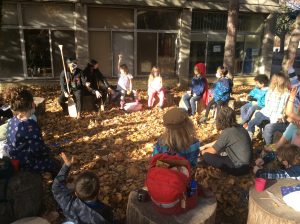
Listen to the City:
As we sit together and breathe, we use our senses to pay attention. I ask students to share what they hear, see, feel, smell. We talk about seasonal changes and transformation. Murphy (2019) calls this practice “Mindful Sensing.” Soundscapes are a dramatic convention that can be used throughout the curriculum, and can be combined with movement. Students use their voices and/or found sounds to tell a story. We have created soundscapes connected to our learning about water and wind. After reading the book, “Listen to the City” by Rachel Isadora, students worked in small groups to create a soundscape about the city and share it with the class.
Blindfold Tree Walk:
In one corner of our school yard, there is a small grove of cedar trees growing together. This area is being cared for and used as an Outdoor Classroom by many educators. One day, we used our sense of touch to do a Blindfold Tree Walk. We worked with a partner to find a special tree. Then, one partner was blindfolded and guided carefully to different trees to touch, until they found their special tree. Before blindfolding students, we talked about what might be challenging for people who are Blind or have low-vision, and how we can support them to walk safely. After participating in this activity, students reflected on the experience, and described what they noticed and how they used their senses to find their special tree. I also tried this activity and was delighted when I reconnected with my tree.
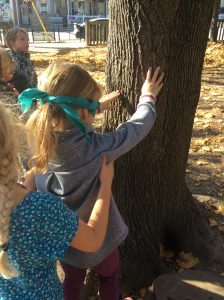
What Does Peace Feel Like?
This activity inspired us to explore another book called, “What Does Peace Feel Like?” by Vladimir Radunsky. This book is filled with the voices of children who use their five senses to describe peace. Students were inspired to write their own descriptions of peace, and used watercolours to paint what peace looks like. We shared our poetry with a special guest who joined us via ZOOM. Donna Jodhan is a disability justice activist who we met ten years ago when she successfully challenged the Canadian government to make websites more accessible for Blind people. It was a wonderful opportunity to celebrate, reflect and recognize the importance of allyship and advocacy.

Loving Kindness:
“Heartprints” are celebrations of when we have been successful at meeting our learning goals. Currently, we are working on the following goals: “I can be a good friend”, “I can keep trying” and “I can solve problems.” After recess, I will often ask students to share a story about when they were a good friend to someone, or when someone was a good friend to them. As they are sharing, I write their story on a heart-shaped piece of paper. These heartprints are hung in our classroom. Heartprints support cooperative learning, encourage the practice of gratitude and sharing appreciation, reinforce positive behaviour, and help us to create an inclusive and kind classroom community.
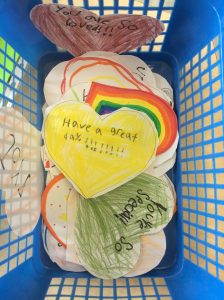
My teacher friend, Kelly Fricker recently supported her Grade 1/2 students to share random acts of kindness and #passiton. Together, they generated a list of positive messages to encourage the adults in the school building, and wrote them on heart-shaped paper. Kelly filled every mailbox with messages such as, “You’ve got this!”, “You are appreciated! ”, “You are my sunshine!” I was inspired and worked with my own students to fill the mailboxes in my school with messages of loving kindness. It was a wonder-full activity. Pass it on!
Virtual Field Trips: Connecting With the World Beyond the Classroom
The pandemic has changed the ways in which we can explore the world around us. Rather than being able to sign up to go on a field trip, many educators are opting for virtual field trips. With so many options out there, how might we ensure that we use these opportunities to connect it back to the learning in the classroom and to life in general? I ask this because I’ve been guilty of giving students these links to get them to simply explore but I wonder if there is more that we might do with these incredible opportunities. In this post, I’ll share a few ideas that I have.
Zoos & Aquariums
The San Diego Zoo and Ripley’s Aquarium are 2 sites for virtual field trips related to zoos and aquariums. I have to admit, these creatures are amazing to look at and I think it’s incredible that we have the opportunity to watch them live.
While watching, it got me thinking about a debate we had in class several years ago about zoos. After researching a variety of animal habitats, we used found materials to create our own zoo of sorts in our classroom. Students were tasked with determining what conditions needed for their animal of choice to survive and to build their habitat. Once all of the habitats were created, we organized the animals into areas that we thought made sense based on their needs. It was pretty cool and it led us to start talking about animals in their real habitats and in zoos.
We researched and discussed differing opinions and feelings about zoos.
A zoo supporter might say:
- The zoo is a fantastic place to learn about and see animals from different parts of the world.
- Zoos help to keep animals safe so that they don’t become in danger of extinction.
- Zoos help to take care of animals who may become sick. In the wild, these sick animals may die.
- Because of pollution and deforestation, animals are having a hard time finding food. Animals in zoos are well fed and taken care of.
Someone who is against zoos may say:
- Zoos don’t teach us much about animals because the animals there don’t act the way they would in the forest, jungle, or ocean, where they belong. We can learn more about animals by reading books or watching wildlife programs on TV.
- Animals are not happy in zoos. They want to be free to walk, run, fly, climb, hunt, and have families. There simply isn’t enough room for them in the habitats that are created at the zoo.
- When a zoo doesn’t want an animal anymore, the animal gets killed or sold to another zoo and might have to travel far away by boat, truck, or plane.
After sharing these ideas, students were asked to reflect on a couple of questions, and as a part of our classroom blog, they shared their thoughts and debated their points with their peers. The questions were:
- What kinds of things do animals need to be happy? Do you think animals in zoos get all these things? Why or why not?
- Think about the animals you’ve seen at the zoo. Do you think there is somewhere else they would rather be? Something else they would rather be doing? Why or why not?
- Do you support zoos? Why or why not?
There was a lot of healthy debate going back and forth as students justified their answers about whether or not they supported zoos.
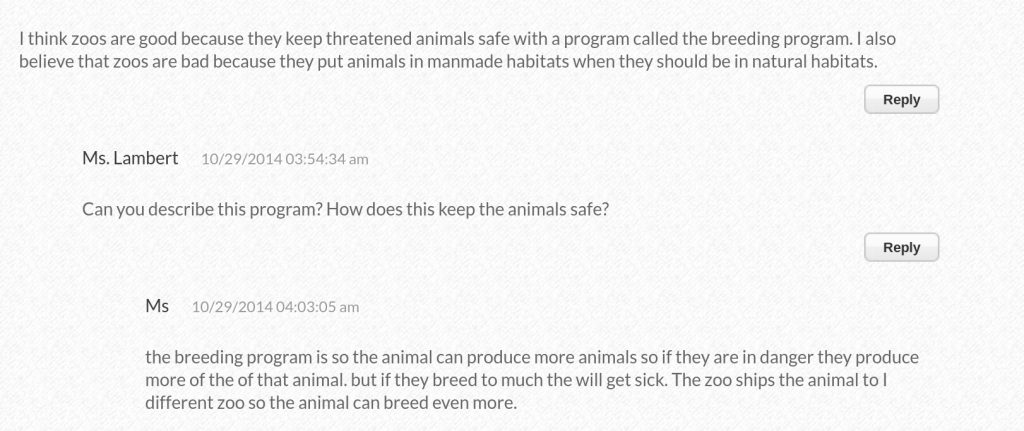
Not only might heading on these virtual field trips be a great way for students to see animals they may not have seen before, but it may also be a great start to conversations around the need for zoos and aquariums and the ethics behind them.
Museums & Art
Art has always been of interest to me. From studying Art from a particular part of the world to understanding how art is connected to culture, so much can be said by looking at a painting or sculpture. Here are a few sites that I’ve explored with students:
- Christi Belcourt – Christi Belcourt is a Métis artist with a deep respect for Mother Earth, the traditions, and the knowledge of her people. In addition to her paintings, she is known as an environmentalist and advocate for the lands, waters, and Indigenous peoples
- Tomb of Menna – Located in Luxor, the tomb of Menna is known for the colorful and well-preserved paintings that adorn the chapel walls.
- The Canadian Museum of History – The mandate of the museum is “to enhance Canadians’ knowledge, understanding and appreciation of events, experiences, people, and objects that reflect and have shaped Canada’s history and identity, and also to enhance their awareness of world history and cultures.”
- The Royal Tyrrell Museum of Palaeontology – Canada’s only museum dedicated exclusively to the study of ancient life.
- The Aga Khan Museum – The Aga Khan Museum presents and collects art from historically significant Muslim civilizations as well as contemporary Muslim communities and diasporas around the world.
When exploring museums and art, I’ve asked students to reflect on pieces that stand out to them and to explain why they were of particular interest. I’ve also had students consider the elements of art – line, shape, texture, form, space, colour, and value – and how the artist used the elements to evoke particular emotions or feelings. I also tend to ask students if there is a particular style that they can attribute to the artists and consider learning more about their particular style. I’ve mentioned before that art is connected to culture. Perhaps posing a question such as, “Is art shaped by culture or is culture shaped by art?”, might spark meaningful conversations around the connection between the two.
Science
Ok…zoos and aquariums fit under this category too. Here are a couple of virtual field trips that my students enjoyed related to physical and earth sciences.
- Slime in Space – This is a 15-minute virtual field trip to outer space to see how slime, and water, react in a microgravity environment.
- Hawaii’s Volcanoes – Take a trip back in time to explore the land shaped by the world’s most active volcanoes.
Everyone loves slime. Ok…well…maybe not everyone. I’ll admit. I’m not a fan. When I stumbled upon the link to Slime in Space, it got me thinking about the time I had a student teach the class how to make slime. It was an opportunity to see the connection between procedural writing for a science experiment and an exercise in problem-solving when it didn’t quite work out. It was an experiment based on the student’s interest and it was amazing to watch them lead their peers with great enthusiasm. When thinking about student interest, last year I had a student who was so fascinated by natural disasters and when it came to exploring Hawaii’s volcanoes, he was all in. This interactive adventure allowed him to learn more about volcanoes and understand how the land was formed in a way that was more real than reading it in a book. How else might we bring student interest into the classroom through these virtual opportunities?
The world is changing and it seems as though virtual field trips are a way to still connect us to the greater world around us. By no means is this an extensive list of what is out there in terms of virtual field trips. Hopefully, this gives you some ideas of how they can be used in the classrooms with students. Have other ideas to share? Please feel free to add them in the comments below!
Write On!
I love to write, and I hope that my enthusiasm for the writing process inspires and encourages my Grade 2 students to write on!
VIP:
At the beginning of the year, we are working together to create a brave and inclusive community where everyone is recognized as a “very important person”. The VIP program celebrates one student each day. Everybody has a story, and we learn about the VIP by listening and asking questions. Together, we talk about what good writers do as we write several sentences about the VIP. We notice the letters in their name and practice printing them correctly. Then, everyone draws a picture and writes about the VIP. These pages are collected and sent home as a book for the VIP to share with their family.
On the first day of school, I was the VIP to model the process. Yes, I was wearing a cape at the time, to demonstrate our superhero arms-distance protocol, and to reinforce that we all have superpowers.
The Peace Book:
Every year on September 21, we recognize the International Day of Peace as part of Peace Week. Peace Week is an excellent opportunity to introduce and/or review the Zones of Regulation and practice mindfulness strategies. We share ideas about when we feel peaceful, and brainstorm agreements for how we might resolve conflicts and solve problems in our community. We sing songs and read stories about peace and justice. After reading “The Peace Book,” by Todd Parr, we created our own classroom book inspired by his book.
Poetry:
In the early primary years, students are growing as readers and writers. We all require support to become more independent and confident in our new learning. Writing prompts and predictable structures can help emergent writers to get started and complete their work.
On the first day of fall, we wrote short poems called “Good-Bye Summer! Hello Fall!” We generated ideas for our writing by sharing what we love about summer and fall in a Knowledge Building Circle. We also used Drama to play out our favourite activities and connect our bodies to our learning. We sang songs about the signs of fall, drew pictures, and wrote about what we noticed in our Nature Journals.
MSI:
In my first year of teaching, I started as a Long-Term Occasional from October-June. The teacher who left was exemplary, and she had established a program called MSI: Math-Science Investigation, which I continue to this day. Before STEAM, there was MSI. It involves solving problems through building.
During MSI, I invite students to build a structure connected to our current inquiry (e.g., build a structure that includes a repeating pattern, build a habitat for an animal, etc.) After building with different materials (e.g., pattern blocks, straws and connectors, corks, Lego, etc.) students will write and draw about their structures in their Math Journals.
When I asked students to build a structure connected to water, they made: a hydroelectric dam, salmon, a lake, pipes, a boat, and a machine that turns saltwater into freshwater.
Toy Day:
Every 6-8 weeks, I organize a Toy Day in our classroom. On this day, everyone is invited to bring a toy to share. We use these toys as provocations for many learning activities in the classroom, including Drama, Math, Writing, Media Literacy, Art, etc.
At the beginning of Grade 2, I am collecting diagnostic assessment data about my students, and I always use the Grade 1 Ministry of Education writing exemplar, which is descriptive writing about My Toy. After sharing and playing with our toys, students are motivated to write and draw about their toy.
Goal-Setting:
COVID-19 has impacted student learning in different ways. There might be gaps in achievement, which need to be identified before we can build new skills. I will use the assessment data to develop individual short-term writing goals with each student, and support everyone to work towards meeting their goals. When students work towards individual goals that are “just right” for them, they can always feel successful. These writing goals will also be shared with families, to strengthen the home-school connection and encourage a relationship of collaborative assessment.
Community Immunity!
COVID-19 has turned everyone into a first-year teacher. It doesn’t matter how many years of experience you might have, because this year is unlike any other that we have ever experienced. All of us are re-imagining new ways to connect with students, whether you are learning together on-line or in-person. It is a very humbling experience to be starting from scratch.
I have chosen to teach in-person because I crave community and collaboration. The weeks leading up the first day of school were frustrating and stressful. Everyone was scared and nervous as we struggled to create new routines and protocols. As soon as the students arrived, I began to relax. There is still so much that is unknown and unpredictable, but I know how to play and learn with children.
Here are some of my insights from the first few weeks of teaching Grade 2.
Sign Language:
Wearing masks makes it very difficult to communicate clearly. We cannot read each other’s lips or facial expressions, and it is hard to hear each other. For those of us who are teaching outside, our voices are struggling to project. I grew up with a father who was deaf-blind. As a child, I learned about barriers, disability justice, and how to communicate with my hands.
I worked with my students to develop simple signs that we can use to help us communicate. We have symbols for: turning up the volume, sharing the same idea, making connections, asking to use the washroom or get a drink of water, and letting someone know we are smiling underneath. I made a short video, which I shared with my families after the first day of school. Send me an email if you would like me to share it with you.
I also bought myself a voice amplifier, which helps everyone to listen, and makes me feel like a rock star!
Drama and Play:
Drama is a powerful way to teach and create community. I have been using role-playing and charades to practice and reinforce new routines, and problem-solve different scenarios. I believe in the possibilities of play, and I am holding space for us to play together. After months of isolation and loss, we all need to connect and have fun!
Every morning, after pre-screening and sharing our connection to land, we play a few cooperative games. We have been learning each other’s names by clapping out syllables, using gestures or wordplay, such as “Very Velvet”. We ask questions and “Step into the Circle”. We change places with someone else “When the Big Wind Blows….” and we try to guess who is leading the action in “Follow the Leader”.
My teacher friend, Peyton Leung, shared this link of Socially Distant Outdoor Games for Kindergarten-Grade 8. Check it out! Also, here are some Drama Games that will work on-line and in-person.
Outdoor Learning:
All the educators at our school are trying to spend as much time outside as possible. We know that learning outdoors is safer, and we are transforming our pedagogy by teaching and learning outdoors. There are many challenges to overcome, including city traffic and construction noise, carrying the materials you need everywhere you go, the lack of shelter and easy access to washrooms, etc. We are embracing the “big ideas” of change and adaptation and using our imagination to co-create new possibilities for education.
Kindergarten-Grade 6 students have been exploring measurement and mapping, as we connect with the different areas of our school yard. Inside our “portable desks” are materials we can use for documenting our learning. We are all learning how to keep our knapsacks organized and take responsibility for the extra masks and layers, hand sanitizer, “sit-upons” and school supplies.
This year, we will be deepening our understanding of land education and collaborating with Doug Anderson, who is one of the co-authors of Natural Curiosity 2nd edition: The Importance of Indigenous Perspectives in Children’s Environmental Inquiry. We will explore a pedagogy of relationships, and honour land as first teacher.
There are extensive resources that connect Outdoor Learning to the Ontario Curriculum. These Kindergarten-Grade 8 activities were created by the Peel District School Board Field Centre Instructors. Please share other resources that are supporting you to do this work.
Bitmoji Education
 Love it or hate it, the app of Bitmoji has worked it’s way into education and particularly into distance learning. From “digital” stickers for feedback to entire Google Slide Classrooms with doors to other rooms, Bitmoji is everywhere. Bitmojis are dancing, pointing and fainting all over educational platforms. Confession time? I’m on the love it team and I’ll tell you why.
Love it or hate it, the app of Bitmoji has worked it’s way into education and particularly into distance learning. From “digital” stickers for feedback to entire Google Slide Classrooms with doors to other rooms, Bitmoji is everywhere. Bitmojis are dancing, pointing and fainting all over educational platforms. Confession time? I’m on the love it team and I’ll tell you why.
Bitmoji allows for a personal and creative touch to things that we share with others. When I create short Google Slide presentations for students they are surprised to see my Bitmoji in the corners of my presentation. Some think it is truly “geeky” but many students appreciate the effort at making the presentation a little more fun. Not having to put my real profile photo on something and being able to add a Bitmoji instead provides a small layer of privacy. I began to make virtual, interactive classrooms on Google Slides and soon realized design and creating something so personal was a throw back to the many hours I spent playing with Barbies as a kid. It was like planning to remodel my kitchen but without any cost what so ever. It doesn’t feel like work. It feels like play. 115,000 members on the “Bitmoji Craze for Educators” Facebook page all agree that it is a type of escapism and the membership grows daily.
Colleague Deanna Palmer and I created a webinar workshop for our fellow teachers about how to use Bitmoji to add some Pop to distance learning. In the webinar we included a step-by-step slide show for educators to take away. Find it here: Using Bitmoji to Make Virtual Learning Pop
Like with any popular craze or fad there are those who don’t or won’t buy in. Some teachers are reluctant because they are conscious of their digital footprint-especially since in order to create the animated virtual reality Bitmojis you need to have a Snap Chat Account. Some teachers don’t think that their students will want to see their teacher’s cartoon face all over everything in their classroom. I can appreciate that it isn’t for everyone. I am well aware that making learning “fun” or “cute” doesn’t make it deep or engaging. However, if a picture can be worth a thousand words and Bitmoji can express precisely what we are feeling. Using a Bitmoji might resonate with a colleague or student and just might make them smile. If that is what my little Bitmoji avatar does, then it was worth it.
does, then it was worth it.
What’s Working?!?
Ok…so the title is truly a reflection of my uncertainty of what is in fact working in this thing that I have called distance learning. Over the past 10 weeks, I’ve been engaged in this process with students and as we approach the final month of the year, I’m taking some time to reflect on what has – in my opinion – worked, at least for me and my students. Don’t worry, it will be a short list so not to worry about a never-ending post here!
Google Meets
Since our first week of distance learning, we’ve had Google Meet sessions that have been audio only. During these times, we’ve done check-ins and it’s also been a great tool for helping small groups through mini-lessons. Over the past couple of weeks, they have shifted slightly where students have been the ones to suggest things that we might do during our Meets. We had a Connect4 tournament and we’ve also had a couple of students who created and shared short trivia games. What I’m noticing is that these times are becoming more and more social and less and less about “the work”. Which is an education in itself. Don’t get me wrong, we work through any questions students have but it’s becoming a more comfortable forum to share in a more social way. I’m still navigating some of the ideas of great uses for Meet and would welcome any suggestions people may have.
Podcasts
Last month, I introduced my students to the Six Minute Podcast and I must admit that it’s the one thing that is probably the most talked-about or the activity that is most tried during the week. I’m actually surprised at how many have enjoyed listening and having discussions about it. The podcast is a serial story about an 11-year old by the name of Holliday. She is pulled from the icy waters of Alaska with no memory of who she is or where she came from. She is “adopted” by the family who found her and when she begins to develop incredible abilities, she soon discovers that she’s not alone in the world. There are so many twists and turns in each episode and many can’t wait to find out more. As we have listened, we learned about writing summaries, making and justifying choices, character analysis, and more! I think when we start again in September, podcasts might be something that we keep.
Design
While I personally understand the impact of the trauma caused by the current pandemic, I felt it necessary to speak about it in an age-appropriate way with students. Having a number of students with parents as frontline workers, I knew that their experiences would definitely have an impact on our learning. We’ve been doing a design sprint – well…maybe more like a marathon at the moment – and it’s been incredible to see how it has empowered students to think about themselves as being incredible problem solvers. Today I had 3 students pitch their ideas during our whole-class Meet and I was blown away by what they designed to solve problems for people. They thought of it all. From holographic watches to stay connected with family to a new company designed to train and employ individuals to make personal protective equipment for the community, when implemented, their solutions can have an amazing impact! Through this work, they are really understanding that they have the power to bring about change not just for themselves but for others.
Art & Physical Education
While the Arts and Physical Education haven’t been the focus of the Ministry of Education during this time, I’ve been adding them to our weekly schedule. It’s made the world of difference for some of my students. The ability to express themselves through the Arts and Physical Education has been incredible. We’ve created a classroom Art gallery and many of my students plan weekly Phys. Ed. challenges for their classmates. When I see schools re-opening and subject areas like Physical Education aren’t being included, I wonder what further trauma this might be on students who rely on these subject areas as an essential part of their school lives and their general wellness. I worry.
As I reflect on this past month, I think we’ve had many successes and these are just some of the reasons why. I’m not sure what June will hold and I guess we’ll see!
Inspiration During the COVID Crisis
I know that as I write this, I speak from a fortunate position. We are working safely from home and all of us are still healthy. Other than not being able to see extended family and friends, having some aches and pains from being in front of the computer and get out to the hair dresser, my family is coping pretty well with isolation. While so many are suffering it has been humbling and inspiring to witness the resilience, creativity and kindness of those around us.
Music is everywhere. Concerts on television bringing Canadian artists from their living rooms to ours, live Facebook concerts of our favourite Canadian musicians, and videos from friends and family sharing their music. This week I joined a virtual Ukulele play and sing along with the Bytown Ukulele Group from Ottawa. I played and sang along with people from British Columbia, Ireland, Nova Scotia and here in Peterborough!
Art is everywhere. People are painting anything and everything! From rocks to sea shells to paint nights with friends. There are sketches and sculptures and pottery being made. From digital art to creating sketches from tutorials with famous artists; people are creating all kinds of beautiful art.
Dance is everywhere. There are Tik-Tok videos of dances making teenagers get up and move and follow along. Dance studios are going online to continue extra curricular dance lessons. 30 second dance parties are happening in my living room whenever we need a break from the computer screen. Thankfully, none of that is being recorded!
There is culinary prowess being celebrated. Yeast and flour are hot commodities right now because people are trying their hands at baking bread. People are posting meals they have never made before and swapping recipes with friends. People are growing things on their windowsills and in their backyards for the first time.
Innovation is everywhere. People are trying their hands at DIY projects and coming up with innovative ways to connect online. Teachers are learning digital tools they have never used before in order to connect with their students. We’ve been participating in online trivia and poker nights. My son plays Jackbox party games with his friends while also chatting online or streams a movie together.
Most of all, I have witnessed incredible kindness. I joined a Facebook group called Peterborough Shares. At first it was mainly to communicate where to find particular grocery items and post information about shopping etc., It has since become a forum of connection where people ask for help and others respond. From a new mom recently unemployed to a family who lost their home to fire, people are answering to the calls for help. Something as simple as finding left handed scissors for a child to complete schoolwork or finding a hand crafted Mother’s Day gift, people are coming together to share that information and supporting one another in an unprecedented way. More than ever, my city feels like a community.
I know I am in a fortunate position. I am grateful every day that we took my 87 year old mom out of her retirement home when this all began and that she has remained healthy. I am grateful that my 16 year old son has friends he connects with, teachers who care and a love of artistic things that feed his soul. I am grateful that my husband and I can work from home and that he goes out and bravely gets the things we need. I am grateful that in the middle of all of the chaos, in the middle of the grief and sadness, there is hope.
I Am From Poems – Building A Positive Classroom Community
I’m hoping that it’s been a great start back for everyone! The month has certainly gone by quickly. Having been out of the classroom for a year and being at a new school community, it was definitely all nerves on the first day. I always try to keep in mind that students might be feeling the same way walking into the new school year. While many of my students have been in the same school together since kindergarten, I have a few students who are new to our school this year and have been thinking of ways to make sure that they feel right at home in our classroom.
Building a positive classroom community is important starting from day one. As a part of building our classroom community, I often ask students to consider who they are as individuals and what they bring to our classroom space. One activity that I have enjoyed over the years is creating I Am From poems. In the past I’ve jumped right into creating We Are From poems where students work with a partner to find commonalities and differences and share them to the larger group. Once they have created a joint poem, we combine different parts of each poem to create one large classroom poem where everyone is reflected. This year, instead of creating We Are From poems, we started off instead by creating our own individual poems to share with each other.
You might be wondering what I Am From Poems are. For years, educators have used George Ella Lyon’s Where I’m From poem to inspire students to consider their own narratives. While there are different templates that can be used, I use this template to help guide my students in creating their own.
On the second day of school, the students in my class were tasked with thinking about who they are and where they are from, learning that our experiences shape who we are as individuals, along with other factors in our lives. By the end of the week, rough copies of amazing poems were complete and students were thinking about the symbols they would use to represent their identities. Just in time for our Curriculum Night, good copies of our poems went up and we had the chance to create continuous line portraits to accompany them.
Identity work is so important for building a safe and caring classroom community. What ideas do you have for this year? How are students showing who they are and bringing their experiences to the classroom and their learning? If you have great ideas, please share them here!
Inquiry Project
As part of a board focus group I am involved with, I am exploring along with a group of six other teachers, the inquiry model in the classroom. Each group that has gathered together to focus on inquiry looks at how it works in their classroom in a different way. My group has selected questioning. We are looking at how and if students select better questions, they will become more successful.
I just recently came back from Disney this Christmas break and I was overwhelmed with the many posts on instagram telling me what cool food I could find at literally every inch of the parks. There were so many options and I had to try them all and take pictures of them all. This has been an interest of mine for some time now, finding a really cool looking item of food and taking a picture with it. I came home from the trip feeling inspired and thinking, I can explore this phenomenon with my class of motivated grade eight students.
At first I posed it to them as a question, what are the most trending items right now on instagram. They came up with a huge list and then I made them create the questions. They came up with a few deep questions: Why do things trend? What makes an item trend-worthy? How can we explore a trending item in our classroom? What item could we produce as a class? It took us a while to get there but we figured out that it would be cool to market a food item as a class and then create it and sell it.
Since we were just finishing up our data management unit, we talked about how can we gather results from our student body about what item would be a hit in our school? First, we asked our office staff for advice about this exciting project. We were given the okay to market and sell an item as long as proper food handling techniques were followed. We then talked about what are the top six trending food items right now? We came up with six as a class: donuts, cookies, cupcakes, bubble tea, smoothies and the Harry Potter beverage. My students paired up, created a google survey and added all these options to the survey. They emailed every teacher in the school setting up meeting times to survey their class.
Before we analyzed our results, on our inquiry wall we came up with ways our project hits every subject we study. We talked about the literacy connections to marketing, advertisements, etc. We talked about art connections when designing logos, posters, maybe even creating a wall that would be a backdrop for a cool photo with our finished product. We talked about math connections when coming up with the cost of the item, the cost of ingredients, the profit calculations, etc. We made large lists for each subject so we can see how wide this one small question covers.
We have now gathered all our results and the top choice for our school was smoothies. We have now created a list of what to do next. It is on our inquiry wall along and our team leaders will check off our ideas as we complete them.
I would love to say we work on this six periods a day, which we very well could since it covers many expectations in each subject, however, grade eight is such a huge year that there is always so many other things that we have to be working on. Currently, we work on this project one period a day. We have 25 entries for logo ideas, 10 entries for company name and probably over 100 smoothie ideas. We will be narrowing down our choices on Monday.
I will keep you all posted on our progress! It is turning out to be a great project and the engagement level is incredibly high. We all sit around the back inquiry board and the hands that go up for ideas during this project are not up for any other time of day. My students are excited about the possibilities that this project presents. It is fun turning over everything to the kids and seeing how it all ends up!

